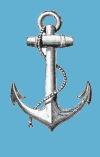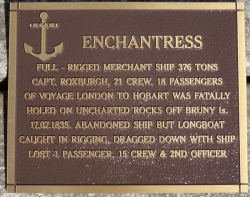 |
Tasmanian Seafarers' Memorial
|
 |
Enchantress (1835)
Enchantress
Full-rigged merchant ship 376 tons
Capt. Roxburgh, 21 crew, 18 passengers
on voyage London to Hobart was fatally
holed on unchartered rocks off Buny Is.
12.02.1835. Abandoned ship but longboat
caught in rigging, dragged down with ship
Lost 4 passengers, 15 crew and 2nd officer
Since writing the details below further information has come to hand that shows there were two vessels names Enchantress and there is much confusion about which facts belong to each vessel. The record below will be amended to show the correct detail for the Enchantress to which the plaque refers. Both ships sailed to Sydney and Hobart Town, both had the same ownership and both were wrecked, all to add to the confusion.
~~~~~~~~~~~~~~~~~~~~~~~~~~~~
The Enchantress, a full-rigged ship of 376 tons was a trader between London, Sydney and Hobart from 1832 and involved at times in transporting convicts and passengers. In 1833 she carried 199 male convicts to Hobart.
On the voyage from London to Hobart on the 16th July 1835, the Enchantress, under Captain David Roxburgh, was carrying 21 crewmen, 18 passengers and cargo.
She made landfall about 12 miles north of South West Cape and decided to seek an anchorage in the D'Entrecasteaux Channel to avoid being blown to the eastwards.
The following day she tacked backwards and forwards across the southern entrance to the channel and around 10 pm on the 17th July near Bruny Island, the captain decided to tack offshore and went below to check his charts.
He was only below deck for around three minutes when the ship was fatally holed by hitting uncharted rocks half a mile off the western shore of Bruny Island and six to eight miles off Partridge Island, probably the Hen and Chicken Reef. She was holed so severely that the crew abandoned her before she sank.
However, the longboat caught in the rigging and was dragged down with the ship with loss of the second officer, fifteen crewmen and one passenger.
The survivors landed on Partridge Island and the passengers were picked up by the cutter Friends and taken to Hobart, while the captain and the four surviving crew set off for Hobart in the gig.
The tragedy led to a call for properly regulated and paid pilots to be stationed in the dangerous parts of the coast, and for the establishment of a light house in the D'Entrecastreaux Channel.
It was considered that, had there been any pilots or a light-house near the Actaeon Reef, the wreck of the George III, and the Enchantress , would in all probability have been prevented - and the loss of lives thus avoided.The Mercury (Hobart, Tas.) Saturday 20 July 1935 p 5 Article
DURING the Autumn and early Winter of 1835, several tragedies occurred around the coast of Tasmania. The first notable one was the wreck of the transport ship George III ., which took place near the Actaeon reef, in the D'Entrecasteaux Channel, on April 13, with the loss of 134 lives. Next came the wreck of the transport Neva , off King Island, in Bass Strait, when 227 persons lost their lives. Two months later, on July 17, another vessel, the Enchantress , was wrecked in the D'Entrecasteaux Channel, very close to where the George III was lost, 17 persons losing their lives.
A feature of the wrecks of the Neva and the Enchantress was the rapidity with which both vessels broke up after first striking. The Neva went to pieces in half an hour and the Enchantress in less than 20 minutes.
Struck a Reef
Officially, the Enchantress was wrecked on Bruny Island, but this was not so. A study of the report of the wreck, and the captain's statements, as published at the time, combined with a study of the Admiralty chart, shows that the vessel was lost on the southern end of the Actaeon reef by striking on the South Break. The only happening apparently inconsistent with this was the landing of the survivors on Partridge Island. The captain's statement is full of inconsistencies.
The Enchantress was a merchant ship, and was on a voyage from London to Hobart Town, under the command of Captain Roxburgh, when she was lost. Her crew consisted of 21 and she carried 18 passengers. A good run had been made from London, and the South-West Cape was sighted in the evening of July 16, which was a Thursday. The following day the wind came away hard from the North East, and, being short of fresh water, Captain Roxburgh decided to enter the D'Entrecasteaux Channel to seek an anchorage as he was afraid of being blown offshore. In his statement, he said that about 10 p.m. on the 17th, he tacked ship from the western shore, which was then not more than half a mile distant. He and the chief officer then went below to examine the chart. Three minutes after going below, and before the vessel had been on that tack (port), ten minutes, she struck on some rocks running a considerable way from the shore, about six or eight miles below Partridge Island, on the Bruny side of the Channel.
The yards were backed and the ship floated off. The well was immediately sounded, and 3ft. of water was found in the hold, in another two minutes there was 5ft, and speedily afterwards the soundings gave 9ft; the ship was now waterlogged and unmanageable and orders were given to clear away the boats. The first officer and male passengers went to the quarter boats, while the second officer and crew went to the long-boat.
The Boats Manned
The quarter boats were lowered and filled with passengers, the ship by now was settling fast. Ordering the boats to wait, Captain Roxburgh ran down to the cabin where he managed to get hold of the ship's papers and chronometer. Regaining the deck he jumped into the cutter, at the same time calling out to the crew to hurry up in launching the long-boat. The quarter boats then pushed off, but had barely got 20 yards away when the ship went down, head foremost, taking with her 17 members of the crew and one passenger, all of whom were working at the long-boat. The captain stated in his report that the vessel went down in from 15 to 20 minutes after first striking.
The survivors were in the boats all night, making a landing on Partridge Island at 8 o'clock the next morning.
They remained there all that day and the following night, suffering severely from cold and hunger. On Sunday morning, the 19th, they were rescued by a Mr Madden, by means of the sloop Friends.
Captain Roxburgh, with two or three others, went to Hobart Town in one of the ship's boats, arriving there on the Sunday evening. Captain Moriarty, the Port Officer, left for Partridge Island as quickly as possible by steam boat with food, clothing and comforts, which all, especially the ladies, were badly in need of.
The following is a list of the passengers who were saved : Mr. Anstey, Mr. and Mrs. Butler, Mrs. Yates, Miss Dixon, Miss Smith, Mr, Mrs and Miss Rens, Dr Lightfoot, Mr McArthur, Mr and Mrs Burns and four children. The captain, first officer, steward, and three boys were the only members of the crew saved.
Hobart Comment
The Hobart Courier a week later commented on this tragedy as follows "As this distressing event has happened without a pilot being on board, though the ship had reached so near port, we trust that some immediate steps will be taken, now that the trade of Hobart Town is so much increased, to lit out properly decked pilot boats, the same as in England, which can proceed to a distance of 10 or 20 miles out to the open sea, looking for the approach of vessels, a thing which is wholly impossible with the present system of open whale boats. The pilots should also be remunerated, as we conceive, in the same manner as in England, where he that first boards the approaching ship receives the pilotage; not as at present, paid by salary or equable division.
"We trust also, now that the means of diving and recovering property sunk in this manner is so well understood, and so easily and so cheaply accomplished, that an attempt will be made to recover some of the property. The cargo of the Enchantress is said to have been exceedingly valuable, and the part which was insured was entered far below its real value. A great part of the ship and cargo belonged to the unfortunate captain. We have used our best exertion to obtain an authentic account of this distressing shipwreck, and hope to give still more particulars, that can be equally relied upon, in our next."
No further particulars appeared, and no further reference was made about the wreck. The glaring inconsistencies in the captain's report, the sudden sinking of the ship, the loss of most of the crew, and the fact that the captain was the chief man interested in the ship and cargo, gives a student of these matters plenty of food for thought.
![]()
